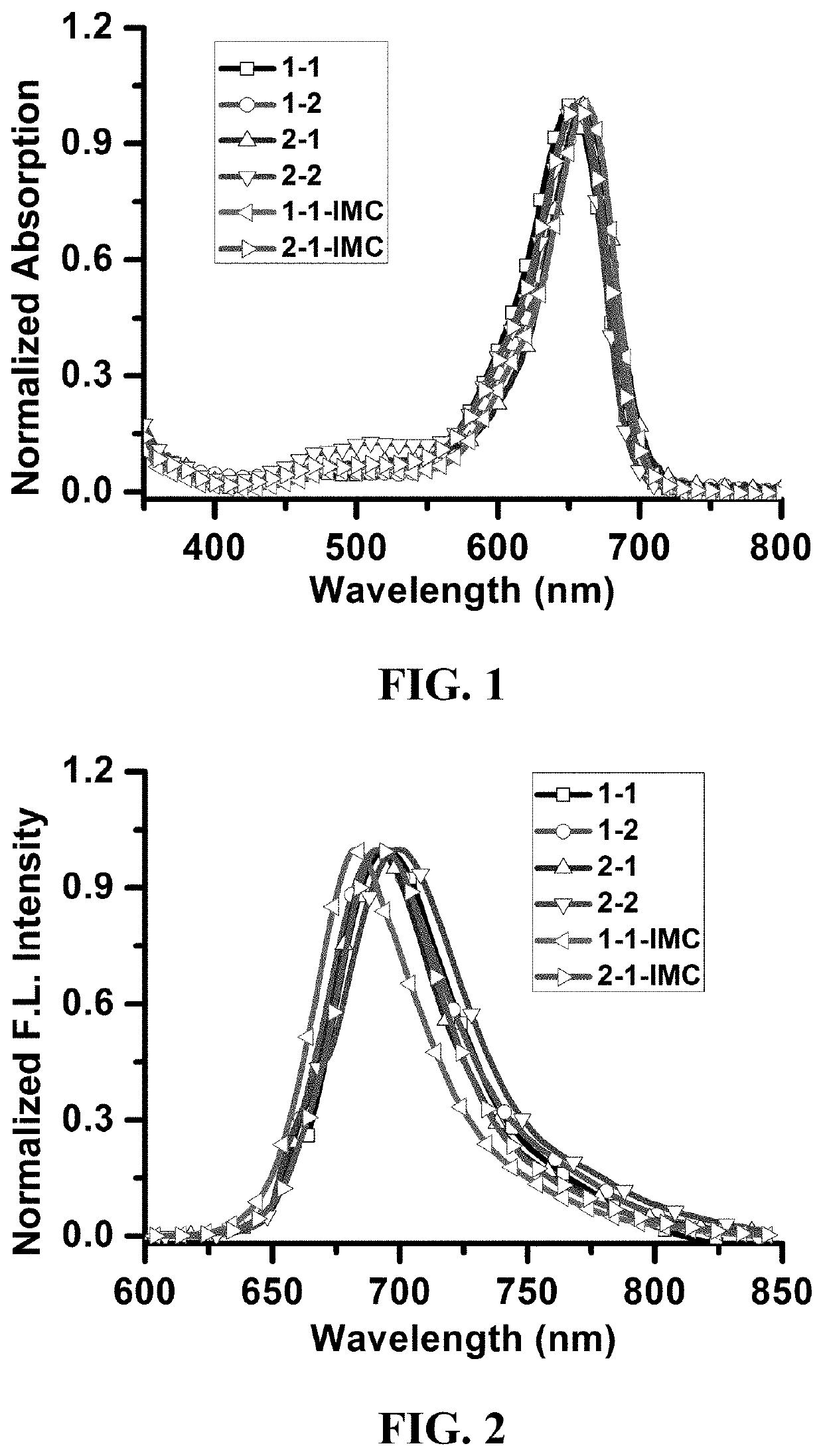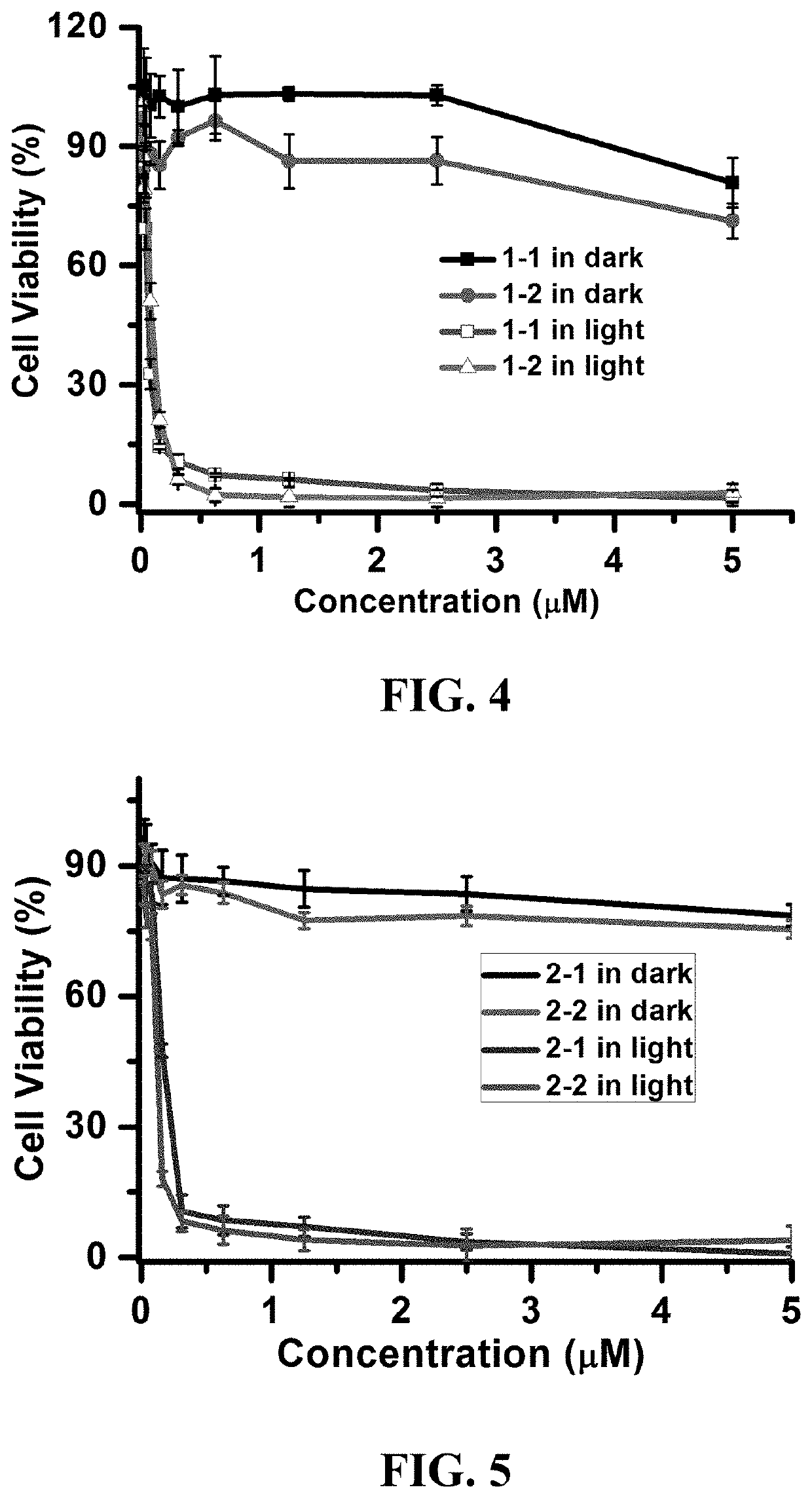Photosensitizer and derivatives and application thereof
a technology of photosensitizer and derivatives, applied in the field of anticancer drug design and synthesis, can solve the problem of relatively few studies on this kind of photosensitizer
- Summary
- Abstract
- Description
- Claims
- Application Information
AI Technical Summary
Benefits of technology
Problems solved by technology
Method used
Image
Examples
implementation example 1
[0105]Synthesis of benzophene thiazine photosensitizer 1-1, 1-2:
[0106](1) Synthesis of Intermediate i
[0107]In 10 mL aqueous solution, 4-amino-N,N-diethyl aniline (6.09 g) and aluminum sulfate (4.11 g) are added. Then, the sodium thiosulfate (2.21 g) and zinc chloride (0.872 g) are added into the flask under ice bath. After that, 4 mL potassium dichromate aqueous solution (0.42 mmol) is slowly added and, continue to stir for 2 hours. After the reaction is finished, the crude produces are filtered, getting t a gray-black solid. Then, the filter cake is washed with acetone and ether, and then refluxed in 10 mL methanol for 20 minutes. 0.76 g light grey solid product is obtained after filtering, with a yield of 47%.
[0108](2) Synthesis of Intermediate I
[0109]1-bromonaphthalene (4.12 g) and hexanediamine (4.65 g) are added to a round-bottomed flask containing 40 ml of egme solution. Then, CuI (190 mg) and CsCO3 (3.0 g) are added, and the color of reaction solutions is changed from tan to ...
implementation example 2
[0125]Synthesis of benzophenoselenazine photosensitizer 2-1, 2-2:
[0126](1) Synthesis of Intermediate ii
[0127]0.7 g of 3-iodoaniline, 1.7 mL of iodoethane and 1.8 g of PEG2000 are added into 10 mL 40% of sodium hydroxide solution. After stirring at 45° C. for 12 hours, the reaction is cooled to room temperature and extracted with water and ether. The ether phase is collected. After removing the solvent, the crude product is purified by silica gel column chromatography, with yield of 55%.
[0128]Under nitrogen protection, g abovementioned 1 g produce, 0.8 g of copper oxide, 0.6 g of selenium powder, and 0.5 g of potassium hydroxide are dissolved in 15 mL dimethyl sulfoxide, and stirred overnight at 110° C. After the reaction is completed, the reaction solution is cooled to room temperature extracted with ethyl acetate and water. The ethyl acetate phase is collected and purified, giving red liquid products.
[0129]To 60 mL of hydrochloric acid containing the prepared light red liquid 1.2 g...
implementation example 3
[0142]Synthesis of compound 1-1-IMC, 2-1-IMC, the derivatives of benzophenothiazine photosensitizers or benzophenoselenazine photosensitizers conjugated with COX-2 inhibitor indomethacin.
[0143](1) Synthesis of 1-1-IMC, Derivatives of Benzophenothiazine Photosensitizer 1-1 Link with cox-2 Inhibitor-Indomethacin.
[0144]Benzophenothiazine 1-1 (120 mg), indomethacin (110.23 mg), 1-(3-dimethylaminopropyl)-3-ethyl carbon diimine (EDC) (70 mg), HOBt.H2O (70 mg), and 4-methylpyridine (45 mg) are added into 10 mL DMF solution, and stirred for 24 hours at room temperature. After the reaction is finished, the solvent is evaporated under reduced pressure. A blue solid product is obtained by column chromatography with 66% yield.
[0145]Nuclear magnetic 1H NMR (500 MHz, CDCl3) δ 10.94 (s, 1H), 9.02 (s, 1H), 8.92 (d, J=7.8 Hz, 1H), 7.92 (d, J=9.3 Hz, 1H), 7.73 (d, J=7.6 Hz, 2H), 7.61 (d, J=8.3 Hz, 2H), 7.41 (d, J=8.3 Hz, 2H), 7.34 (s, 1H), 7.09 (s, 2H), 6.95 (s, 1H), 6.85 (d, J=9.0 Hz, 2H), 6.58 (d, ...
PUM
| Property | Measurement | Unit |
|---|---|---|
| Toxicity | aaaaa | aaaaa |
Abstract
Description
Claims
Application Information
 Login to View More
Login to View More - R&D
- Intellectual Property
- Life Sciences
- Materials
- Tech Scout
- Unparalleled Data Quality
- Higher Quality Content
- 60% Fewer Hallucinations
Browse by: Latest US Patents, China's latest patents, Technical Efficacy Thesaurus, Application Domain, Technology Topic, Popular Technical Reports.
© 2025 PatSnap. All rights reserved.Legal|Privacy policy|Modern Slavery Act Transparency Statement|Sitemap|About US| Contact US: help@patsnap.com



